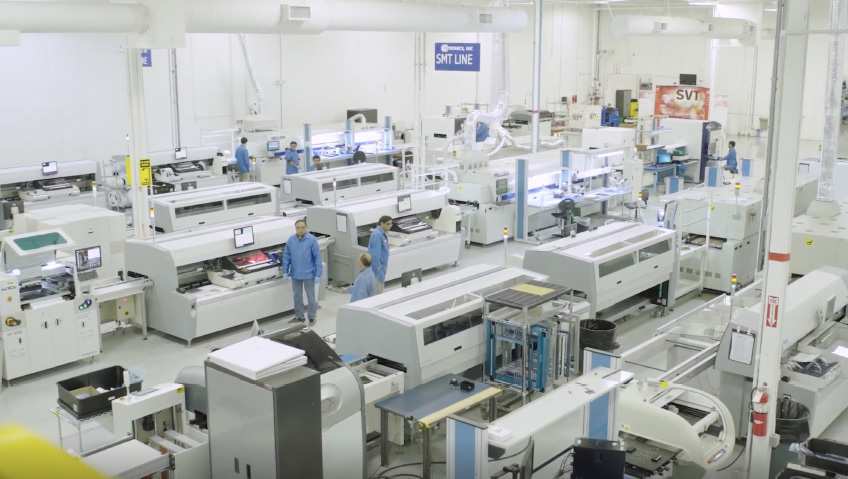For decades now, silicon has been a trusted material in electronics manufacturing due in large part to its use in the creation of semiconductors. Silicon is used among myriad types of electronics today of varying complexity and size, from computers to handheld devices, thanks to its ability to act as both a conductor of electricity and as an insulator (i.e. the role of a semiconductor in a piece of machinery).
Silicon is also a very rich element on Earth still, so it is relatively easy to obtain and harvest for use. Former Intel CEO Gordon Moore purported in 1965 that the number of transistors on a silicon chip would double every 2 years, an idea that would lead the semiconductor and electronics industries forward for decades and would come to be defined as Moore’s Law. The identity of silicon as the key component for semiconductors in electronics means that it is practically ubiquitous in modern devices, but changes may be coming soon in the form of a new type of material with impressive credentials.
The future of electronics seems to be well-suited for a change in materials brought on by the advent of carbon within the space. In a piece in The Philosophical Transactions for the Royal Society A, carbon-based materials were described in 2007 by Robin J Nicholas, Alison Mainwood, and Laurence Eaves as possessing many exciting capabilities for the future of many applications. “Many of these are based on the novel band structure of graphene…which offers the potential for high-speed nanoscale electronics.” Graphene, “a single atomic monolayer of carbon,” can be fabricated onto transistors and has the potential to offer new ideas for the ever-evolving cycle of electronics.
The three authors cite Moore’s Law and offer up that, even in 2007, many researchers were finding that the growth indicated by that law may not be as possible as it seemed over 50 years ago. Although silicon-based transistors and like products have continued to improve in price structure and efficiency over a period of decades, their energy efficiency has plateaued as we’ve neared quantum limits, and companies look toward alternative technology to meet this demand. Different materials are being called on that may be able to offer better performance and functionality, and, of such candidates, carbon is the one that seems to come closest to overtaking or at least meeting silicon.
The positive attributes of carbon and graphene as electrical components and materials are proving hard for researchers to ignore. In her article Computer chips from carbon nanotubes, not silicon, mark a milestone in Science News for Students, Maria Temming purports the facts that carbon nanotubes, when used in electronics, are nearly as thin as an atom and are very good at transferring electricity, making them ideal semiconductors. Quoting electrical engineer Max Shulaker, “Carbon nanotube processors could run three times faster than silicon ones…and they would consume about one-third as much energy as silicon processors.”
Writing for PhysOrg.com, John Messina reports that graphene’s ability for fast voltage travel “translate[s] to carrier mobilities that are hundreds of times larger than silicon chips used today…[making] graphene ideal for faster chip speeds,” while a report for MIT News by Becky Ham details that carbon nanotube transistors are inching closer to being commercially viable because current-day researchers grow ever closer to quick manufacturing by using equipment also meant to produce today’s silicon-based transistors and parts. “Carbon nanotube field-effect transistors or CNFETs are more energy-efficient than silicon field-effect transistors and could be used to build new types of three-dimensional microprocessors,” writer Becky Ham reports.
Max Shulaker again remarks of CFNETs that they are most interesting of all potential alternatives because of their effective energy use and consumption compared to silicon. Carbon-based transistors also run far less hot than silicon-based ones, the latter of which need to be maintained at high temperatures as opposed to carbon, able to exist closer to room temperature and allowing for “fabricated layers of circuits.” Finally, carbon is the fourth most abundant element (by mass) on the globe, so it has potential as a sustainable material, an important focus for countless companies worldwide today.
Carbon and graphene-based electronic materials certainly display a lot of upsides upon inspection but are also not free of drawback, with a couple of points seemingly keeping it from quicker adoption. When used in electronics, carbon nanotubes can tend to lump together which can prevent them from working altogether, and batches of nanotubes tend to contain a percentage of metal which can muddle the ultimate readout of a transistor. Maria Temming feels that newer carbon-based chips will not overtake silicon-based ones any time soon, with silicon chips still running smaller and faster, and silicon itself still being the second-most abundant element on Earth, a considerable lead over carbon’s 4th place.
Chinese researcher Zhang Zhiyong, writing for XinhuaNet.com, notes that, while carbon is a promising alternative, large-scale integration of the material into electronics “have been troubled by fabrication and purity problems.” A move to mass production of carbon would in turn be counter to the original usage for carbon-based units, which used to exist in smaller quantities across academic laboratories. Much is still up to consideration and further research and planning before carbon can fully take the plunge.
Despite its nascency as an electronic material, certain parts of the globe are taking this market endeavour into carbon even further into action. According to an update from XinhuaNet.com written by Guo Ying and Wei Meingjia, researchers in China are pouring significant resources into designing computer chips of the next generation and beyond.
In 2020, Peking University researchers reported on carbon nanotube arrays in high-performance electronics, noting that their performance frequently went beyond that of silicon transistors. A leading researcher, Peng Lianmo, is quoted as saying that carbon nanotubes have the advantages of “low cost, low power consumption and high efficiency, [and] can be an ideal material for developing the next generation of transistors,” in the XinhuaNet piece. The researcher goes on to mention that the opportunities for carbon-based electronics to succeed lie at least partially in governmental support, as China is investing heavily into its chip industry with a willingness to support and investigate new tech.
Interestingly, carbon material continues to evolve even to this day in the electronics space. A report by Rex Merrifield for Horizon Magazine in 2021 tells of a new application for carbon as researchers have developed a mesh, called a “biphenylene network,” that is even more conductive than currently existing carbon materials and still only as thick as one atom. This new material is comparable to graphene in its effectiveness and could be implemented as a carbon-based solution for electronic wiring or for potentially even more solutions. The potential of worldwide adoption is still an ongoing process as both graphene and carbon at large are brought slowly toward viability year on year.
Although it isn’t an immediate replacement for the already heavily embedded silicon in electronics spaces, carbon-based electronics make a compelling case for being a faster and more sustainable element and material for the decades to come. As electronics-based industries endeavour to become more sustainable with practices while also lowering costs and improving efficiency, the need for a material as effective as graphene grows exponentially, so it could be only a matter of time before the leap is made to the swiftness and efficiency of carbon-based materials.






